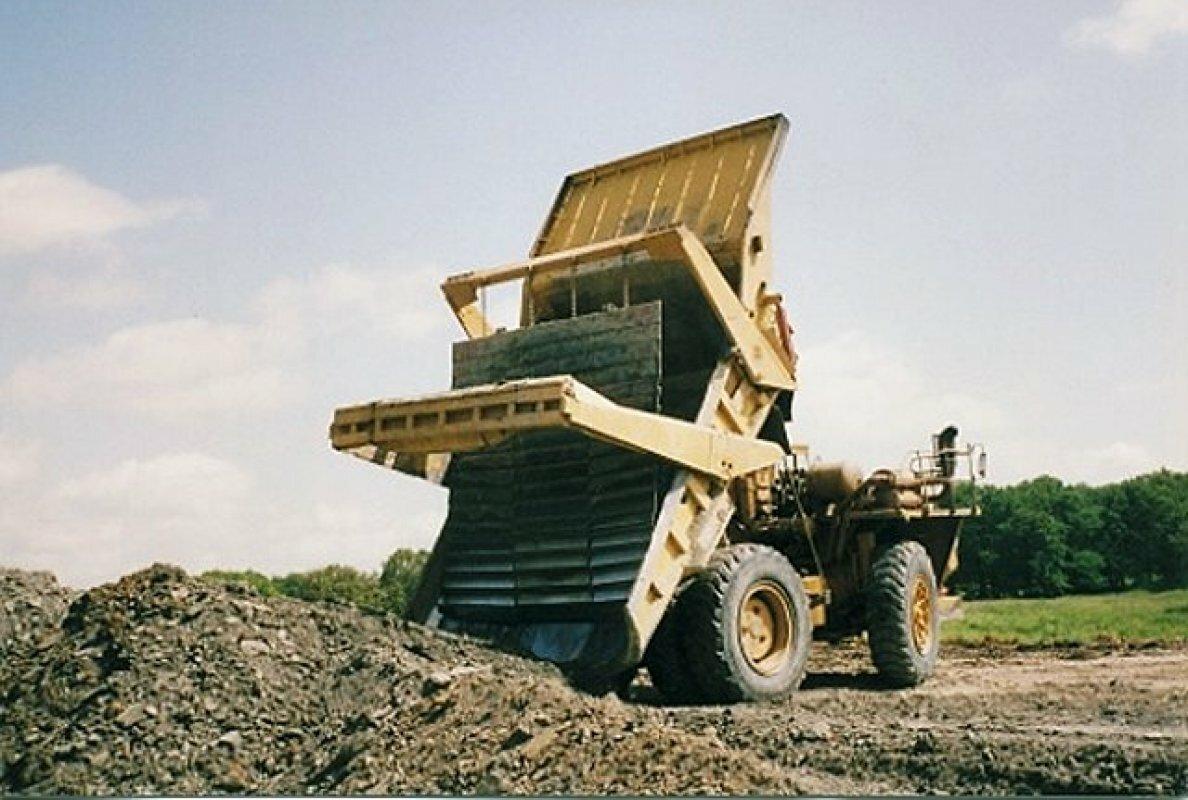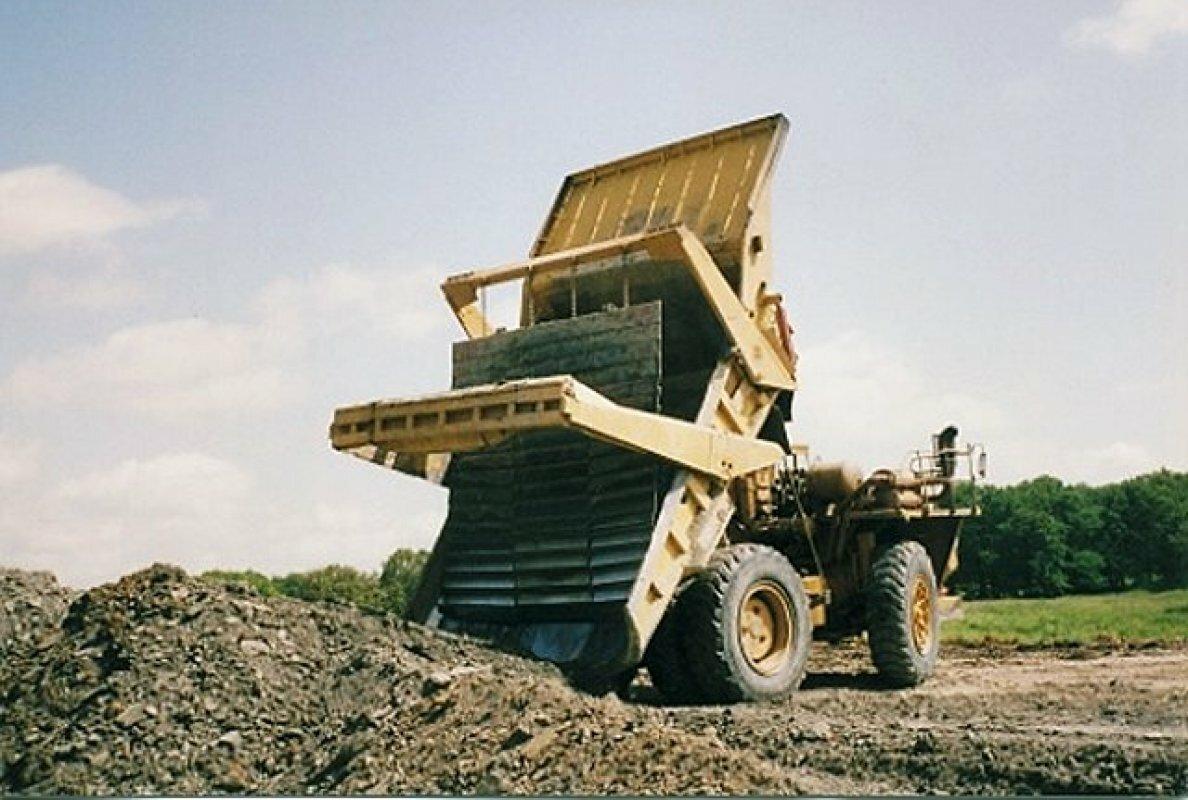Philippi-Hagenbuch Load Ejector System Addresses Material Carryback for Improved Haul Truck Efficiency
 14/06/23-FR-English-NL-footer
14/06/23-FR-English-NL-footer
Le système d'éjecteur de charge de Philippi-Hagenbuch traite le retour de matériau pour une meilleure efficacité des camions de transport
 Philippi-Hagenbuch engineers Load Ejectors with three different mounting styles. The built-up mount provides full-length coverage from the front slope to the body floor. This one is paired with an Autogate® Tailgate for additional haul truck productivity. IMAGE SOURCE: Philippi-Hagenbuch Inc.
Philippi-Hagenbuch engineers Load Ejectors with three different mounting styles. The built-up mount provides full-length coverage from the front slope to the body floor. This one is paired with an Autogate® Tailgate for additional haul truck productivity. IMAGE SOURCE: Philippi-Hagenbuch Inc.
Le système d'éjecteur de charge de Philippi-Hagenbuch est conçu pour éliminer pratiquement tout retour de matière, augmentant efficacement la capacité de charge et améliorant l'efficacité opérationnelle. Cette solution permet aux opérations de transporter la pleine capacité nominale avec chaque charge et de réduire les temps d'arrêt associés à la suppression du report du camion. Les éjecteurs de charge sont conçus par des professionnels pour s'adapter à la marque et au modèle exacts de tout camion de transport hors route à châssis articulé ou rigide et s'adressent aux zones spécifiques de la carrosserie où les matériaux ont tendance à s'accumuler.
Les matériaux collants, tels que l'argile, la saleté, la boue, les cendres volantes et les cendres résiduelles, ont tendance à s'accumuler dans les carrosseries des camions de transport, ce qui réduit la capacité volumétrique lorsqu'ils sont ramenés avec le camion pour le chargement suivant. Le système d'éjecteur de charge consiste en une conception de treillis de plaques articulées superposées qui repose à plat contre la pente avant et le sol à l'intérieur de la carrosserie du camion. Lorsque la benne est relevée, l'éjecteur de charge se sépare de la plate-forme du camion par gravité, éliminant le matériau lorsqu'il est suspendu verticalement à la benne. Cela laisse un camion vide avec sa pleine capacité pour le prochain chargement.
"Nous voyons souvent les opérations accumuler jusqu'à 50 % de la capacité volumétrique de la carrosserie de leur camion en report, et les coûts de transport de ce matériau dans les deux sens peuvent vraiment s'additionner à la fois en charge utile perdue et en usure supplémentaire du camion", a déclaré Josh. Swank, vice-président des ventes et du marketing chez Philippi-Hagenbuch. « L'enlever nécessite des temps d'arrêt importants, non seulement pour le camion de transport, mais peut-être pour qu'une excavatrice racle le matériau et aussi pour les opérateurs qui sont retirés de leurs rôles de production habituels pendant 20 minutes ou plus par camion qui doit être nettoyé. Les éjecteurs de charge aident les opérations à économiser un temps et des ressources précieux.
Chaque éjecteur de charge Philippi-Hagenbuch est conçu par des professionnels pour s'adapter à la marque et au modèle spécifiques de tout camion de transport hors route à cadre articulé ou rigide et pour traiter les zones du corps où le matériau a tendance à coller.
Les ingénieurs de Philippi-Hagenbuch chargent des éjecteurs avec trois styles de montage différents, chacun permettant une installation et un retrait faciles. Le support standard est utilisé pour le report qui s'accumule sur la pente avant du corps mais pas sur la majorité de la surface du sol. Le support intégré est conçu pour traiter les matériaux qui adhèrent à la pente avant ainsi qu'au bas et à l'arrière vers l'arrière du plancher de la carrosserie. Le support rotatif offre une couverture sur toute la longueur de la pente avant à l'arrière du plancher de la carrosserie et s'éloigne automatiquement de la carrosserie du camion lorsque le lit est déversé.
De plus, Philippi-Hagenbuch propose deux options de matériaux pour adapter l'éjecteur de charge à différentes applications. La conception standard est faite d'acier haute résistance de grade 80 et est destinée aux opérations avec une abrasion minimale, tandis que la conception robuste est construite avec de l'acier Hardox 450 pour les applications qui transportent des matériaux hautement abrasifs.
"Nous nous concentrons entièrement sur l'ingénierie de solutions personnalisées qui aident chaque opération à relever les défis uniques affectant l'efficacité de ses camions de transport hors route", a déclaré Swank. "L'efficacité commence par l'utilisation de la pleine capacité nominale du camion, et les éjecteurs de charge permettent aux opérations de transporter ce à quoi elles ont droit avec chaque charge, en utilisant leurs plates-formes de camion existantes."
NJC.© Info Philippi-Hagenbuch Inc.
-------------------------------------------------------------------------------------------------------------
 14/06/23-English
14/06/23-English
Philippi-Hagenbuch Load Ejector System Addresses Material Carryback for Improved Haul Truck Efficiency
 Philippi-Hagenbuch engineers Load Ejectors with three different mounting styles. The built-up mount provides full-length coverage from the front slope to the body floor. This one is paired with an Autogate® Tailgate for additional haul truck productivity. IMAGE SOURCE: Philippi-Hagenbuch Inc.
Philippi-Hagenbuch engineers Load Ejectors with three different mounting styles. The built-up mount provides full-length coverage from the front slope to the body floor. This one is paired with an Autogate® Tailgate for additional haul truck productivity. IMAGE SOURCE: Philippi-Hagenbuch Inc.
Philippi-Hagenbuch’s Load Ejector System is engineered to virtually eliminate material carryback, effectively increasing load capacity and improving operational efficiency. This solution allows operations to haul the full rated capacity with each load and reduce downtime associated with removing carryback from the truck. Load Ejectors are professionally engineered to fit the exact make and model of any articulated or rigid frame off-highway haul truck and address the specific areas of the body where material tends to build up.
Sticky materials, such as clay, dirt, mud, fly ash and bottom ash, tend to build up in haul truck bodies, minimizing volumetric capacity when carried back with the truck for the next load. The Load Ejector System consists of an overlapping jointed plate lattice design that rests flat against the front slope and floor inside of the truck body. When the body is raised, the Load Ejector separates from the truck bed by gravity, removing material as it hangs vertically away from the body. This leaves an empty truck with its full capacity for the next load.
“We often see operations accumulate up to 50% of their truck body’s volumetric capacity in carryback, and the costs to haul that material back and forth can really add up both in lost payload and in additional wear and tear on the truck,” said Josh Swank, vice president of sales and marketing at Philippi-Hagenbuch. “Removing it requires significant downtime, not only for the haul truck but possibly for an excavator to scrape out the material and also for the operators who are taken away from their regular production roles for 20 minutes or more per truck that needs cleaned out. Load Ejectors help operations save valuable time and resources.”
Each Philippi-Hagenbuch Load Ejector is professionally engineered to fit the specific make and model of any articulated or rigid frame off-highway haul truck and address the areas of the body where material tends to stick.
Philippi-Hagenbuch engineers Load Ejectors with three different mounting styles, each allowing for easy installation and removal. The standard mount is used for carryback that accumulates on the front slope of the body but not on a majority of the floor surface. The built-up mount is engineered to address material that sticks to the front slope as well as down and back toward the rear of the body floor. The rotating mount provides full-length coverage from the front slope to the rear of the body floor and automatically pulls away from the truck body when the bed is dumped.
Additionally, Philippi-Hagenbuch offers two material options to match the Load Ejector with different applications. The standard-duty design is made of high-strength Grade 80 steel and is intended for operations with a minimal abrasion, while the heavy-duty design is built with Hardox 450 Steel for applications that haul highly abrasive materials.
“Our entire focus is on engineering custom solutions that help each operation address the unique challenges affecting their off-highway haul truck efficiency,” said Swank. “Efficiency starts with using the truck’s full rated capacity, and Load Ejectors allow operations to haul what they are entitled to with every load, utilizing their existing truck beds.”
NJC.© Info Philippi-Hagenbuch Inc.
----------------------------------------------------------------------------------------------------------------
 14/06/23-NL
14/06/23-NL
Philippi-Hagenbuch Load Ejector-systeem pakt materiaalterugvoer aan voor verbeterde efficiëntie van transporttrucks

Philippi-Hagenbuch engineers Load Ejectors with three different mounting styles. The built-up mount provides full-length coverage from the front slope to the body floor. This one is paired with an Autogate® Tailgate for additional haul truck productivity. IMAGE SOURCE: Philippi-Hagenbuch Inc.
Het Load Ejector-systeem van Philippi-Hagenbuch is ontworpen om materiaalterugvoer vrijwel te elimineren, waardoor het laadvermogen effectief wordt verhoogd en de operationele efficiëntie wordt verbeterd. Met deze oplossing kunnen bedrijven met elke lading de volledige nominale capaciteit vervoeren en de uitvaltijd verminderen die gepaard gaat met het verwijderen van de terugvoer van de vrachtwagen. Load Ejectors zijn professioneel ontworpen om exact op het merk en model van elke off-highway truck met geleed of star frame te passen en zijn gericht op de specifieke delen van de carrosserie waar materiaal de neiging heeft zich op te hopen.
Kleverige materialen, zoals klei, vuil, modder, vliegas en bodemas, hebben de neiging zich op te hopen in de laadbak van de vrachtwagen, waardoor de volumetrische capaciteit wordt geminimaliseerd wanneer deze met de vrachtwagen wordt vervoerd voor de volgende lading. Het Load Ejector-systeem bestaat uit een overlappend roosterontwerp met gelede platen dat plat tegen de voorhelling en de vloer aan de binnenkant van de vrachtwagencarrosserie rust. Wanneer de laadbak wordt geheven, scheidt de lastuitwerper zich door de zwaartekracht van de laadvloer en verwijdert materiaal terwijl het verticaal van de bak af hangt. Hierdoor blijft een lege vrachtwagen met volle capaciteit over voor de volgende lading.
"We zien vaak dat operaties tot 50% van de volumetrische capaciteit van hun vrachtwagencarrosserie ophopen bij het terugvoeren, en de kosten om dat materiaal heen en weer te vervoeren kunnen behoorlijk oplopen, zowel in verloren lading als in extra slijtage aan de vrachtwagen," zei Josh Swank, vice-president verkoop en marketing bij Philippi-Hagenbuch. “Het verwijderen ervan vereist aanzienlijke stilstand, niet alleen voor de vrachtwagen, maar mogelijk ook voor een graafmachine om het materiaal weg te schrapen en ook voor de machinisten die 20 minuten of langer van hun normale productietaken worden weggenomen per vrachtwagen die moet worden schoongemaakt. Load Ejectors helpen operaties waardevolle tijd en middelen te besparen.”
Elke Philippi-Hagenbuch Load Ejector is professioneel ontworpen om te passen bij het specifieke merk en model van elke off-highway dumptruck met geleed of star frame en om de delen van de carrosserie aan te pakken waar materiaal de neiging heeft om te blijven plakken.
De ingenieurs van Philippi-Hagenbuch hebben Load Ejectors met drie verschillende montagestijlen, die elk een gemakkelijke installatie en verwijdering mogelijk maken. De standaardbevestiging wordt gebruikt voor carryback die zich ophoopt op de voorhelling van de carrosserie, maar niet op het grootste deel van het vloeroppervlak. De opgebouwde steun is ontworpen om materiaal aan te pakken dat aan de voorkant van de helling blijft kleven, evenals naar beneden en naar achteren richting de achterkant van de carrosserievloer. De roterende steun biedt dekking over de volledige lengte van de voorhelling tot de achterkant van de laadvloer en trekt automatisch weg van de vrachtwagenbak wanneer de laadbak wordt gestort.
Daarnaast biedt Philippi-Hagenbuch twee materiaalopties om de Load Ejector aan te passen aan verschillende toepassingen. Het standaardontwerp is gemaakt van zeer sterk Grade 80-staal en is bedoeld voor werkzaamheden met minimale slijtage, terwijl het heavy-duty ontwerp is gemaakt van Hardox 450-staal voor toepassingen waarbij zeer schurende materialen worden vervoerd.
"Onze volledige focus ligt op het ontwerpen van op maat gemaakte oplossingen die elk bedrijf helpen de unieke uitdagingen aan te gaan die van invloed zijn op de efficiëntie van hun off-highway-trucks", aldus Swank. "Efficiëntie begint met het gebruik van de volledige nominale capaciteit van de truck, en Load Ejectors stellen bedrijven in staat om met elke lading te vervoeren waar ze recht op hebben, gebruikmakend van hun bestaande laadvloeren."
NJC.© Info Philippi-Hagenbuch Inc.
------------------------------------------------------------------------------------------------------------------
















